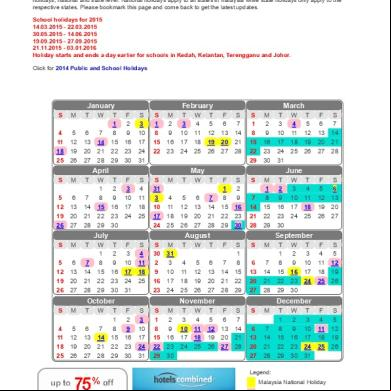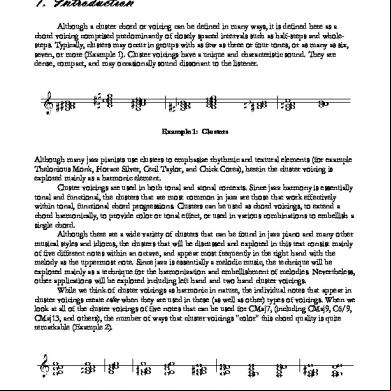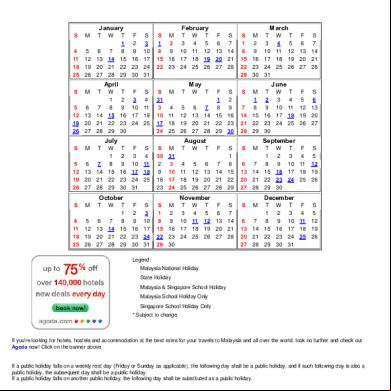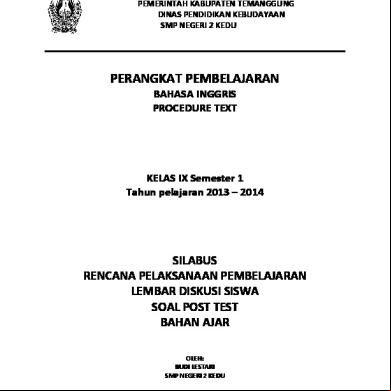Cluster School In Malaysia e3x1h
This document was ed by and they confirmed that they have the permission to share it. If you are author or own the copyright of this book, please report to us by using this report form. Report 2z6p3t
Overview 5o1f4z
& View Cluster School In Malaysia as PDF for free.
More details 6z3438
- Words: 2,173
- Pages: 28
CLUSTER SCHOOL IN MALAYSIA
CLUSTER SCHOOLS
Background The establishment of cluster schools is contained in Chapter 9 of the Education Development Master Plan (PIPP), which was launched on January 16, 2006. Cluster School is based on the PIPP approach to develop the full potential of the cluster schools of excellence in the mechanism described in the Strategic Thrust 6, Accelerating Excellence Institution. Literature review shows that the practice of clustering of schools carried out to improve the quality of education. Groupings are done on the basis of locality or excellence.
Definition Cluster School is a brand name given to the schools identified in the cluster of outstanding aspects of school management and student excel.The creation of the cluster aims to boost excellence in schools in the school education system of Malaysia and develop exemplary school by the school in the same cluster and other schools outside the cluster.
Goal Cluster School was created to boost school performance in the Malaysian education system
• Cluster School Management • Cluster school leaders are: • Principal (DG52/DGA 36) • The selected leaders meet outstanding leaders • Occupation: school-based post • Cluster school teachers are: • Meets criteria Excellent Teachers • The performance will determine whether they remain teaching at the School Cluster • Those who are experts in niche areas of school curriculum in a contract or part-time • Class: teacher ratio is 1:2
• Method of selecting school cluster: • Cluster SBP, SMT and SMKA remain as existing practices • other cluster, the principal / head teacher is empowered to take a small amount of new students to the field of school kebitaraan • School screening test
• The selection of these schools should meet the following and Conditions: • First Prerequisites - Strengthening the School Standards • Schools must achieve a minimum standard of Excellence on Education Quality Standards (SKPM) • Second Prerequisites • Excellence Curriculum (Primary School) • Average Grade School (GPS) for public examination PMR and SPM 3 consecutive years: - SBP: GPS 2.5 and below - SMKA: GPS 3.0 and below - SMT: GPS 4.0 and below - Cm Daily: gps 4.0 and below
• School autonomy: • Type of autonomy granted to the following schools: • • General (for all schools) • Special (in accordance with the needs of schools based on school type, education and niche areas • Autonomy given is guided autonomy need to: • • Compliance with the following standards: • i) Education Act 1996 ii) National Education System iii) the Financial Procedure Act 1957, Treasury Circulars and Guidelines and release letters iv) SKPM
• Autonomy Field List • ii) Management School ii) Human Resource Management iii) Management of Financial Resources and Physical Resources iv) Curriculum Management v) Co-Curriculum Management
HIGH PERFORMING SCHOOLS
WIDENING ACCESS TO QUALITY AND AFFORDABLE EDUCATION – NKRA3
•QUALITY – TO BE RECOGNISED IN THE GLOBAL ARENA •AFFORDABLE – GOVERNMENT & GOVERNMENT- AIDED SCHOOLS
11
MIGRATING THROUGH STANDARDS OF ACHIEVEMENT AND PERFORMANCE HPS is defined as schools with ethos, character and a unique identity which enable the schools to excel in all aspects of education. These schools have strong and excellent work cultures and dynamic national human capital for holistic and continuous development in addition to being able to compete in the international arena, hence becoming the school of choice. •Upward trend academic achievement (take-off value: min. 80% in the public examinations) ; • Malaysian Standard Quality of Education (min. 90% achievement in all dimensions); • Recipient of national and international awards; • Develop leaders with towering personalities; • Benchmark and reference point for both local and international schools; • Smart Partnership with the community • Network with both local and international schools • Linkages with local and international institutions of higher learning.
HIGH PERFORMING SCHOOLS
-
MIGRATING TO
(D) 50%
HPS :
(C) 60%
CLUSTER RESIDENTIAL SCHOOLS ASC PREMIER SMART SCHOOLS DAY SCHOOLS TRUST SCHOOLS
(B) 70%
(A) 80%
100 HPS (A+) 90%
12
PERCENTAGE
LEVEL
90 – 100 %
5 – STAR
HPS/ TRUST SCHOOL
4 – STAR
CLUSTER/ SBP/ PREMIER/ SMART SCHOOL/ TECHNICAL/ RELIGIOUS/ DAY SCHOOL/ TRUST SCHOOL
3 - STAR
SBP/ PREMIER/ SMART SCHOOL/ TECHNICAL/ RELIGIOUS/ DAY SCHOOL/ FELDA/ TRUST SCHOOL
2 - STAR
PREMIER/ SMART SCHOOL/ TECHNICAL/ RELIGIOUS/ DAY SCHOOL/ FELDA/ SPECIAL EDUCATION/ TRUST SCHOOL
1 - STAR
RELIGIOUS/ DAY SCHOOL/ FELDA/ SPECIAL EDUCATION/ SKM/ ASLI/ FELDA/ TRUST SCHOOL
80 – 89 %
70 – 79 %
60 - 69 %
50 – 59 %
SOP/BPSBPSK/12809/SBT
CATEGORY
13
SCHOOL QUALITY PYRAMID (ASPIRED) HPS
90 %
TRUST SCHOOL(TS)
CLUSTER/ SBP/ PREMIER/ SMART SCHOOL/ TECHNICAL/ RELIGIOUS/ DAY SCHOOL /TRUST SCHOOL(TS)
SBP/ PREMIER/ SMART SCHOOL/ TECHNICAL/ RELIGIOUS/ DAY SCHOOL
80 %
70 %
/TRUST SCHOOL (TS) PREMIER/ TECHNICAL/ RELIGIOUS/ DAY SCHOOL/ SPECIAL EDUCATION/ FELDA /TS RELIGIOUS/ DAY SCHOOL/ SPECIAL EDUCATION/ FELDA/ SKM/ ASLI SOP/BPSBPSK/12809/SBT
/TS
60 %
50 % 14
PRIORITISED BIG WINS FOR HIGH PERFORMING SCHOOLS
HIGH
4
9 8
6
3 2 1
5
1.
Announce High-Performing Schools (HPS) at the end of December every year.
2.
Performance based incentives for HPS head teachers and teachers.
3.
Advocate fast-tracking to gifted students.
7
Impact
LOW
4.
10% of the students from HPS will be accepted into the most competitive universities.
5.
All HPS will implement school-based management (Finance, curriculum and teacher selection ).
6.
50% of the HPS will conduct external examinations eg. (New South Wales Examination Certificates) and the results will be published.
7.
100% of the HPS will be evaluated by an independent body and the results will be published (academic).
8.
100% of the HPS will be audited by independent body and the results will be published. (Qualified Auditors).
9.
50% of HPS teaching staff will comprise excellent 15 teachers.
HIGH
LOW Ease of implementation Prioritised Big Wins Selected Big Wins
Obtaining HPS status will only be achievable to schools meeting the stringent requirements Objectives
Examples
▪
Ensure that academic achievement meets the level of the best schools in Malaysia
▪
All HPS should fall within the top 80% of national examination averages for schools
▪
Ensure that non-academic achievement, and school environment is taken into consideration
▪
SKPM of 90% and above a prerequisite
▪
Ensure continuous production of future towering personalities as in the past.
▪
Prime Minister, top-notch academicians and professionals
▪
Ensure that school is continuously benchmarked locally and internationally.
▪
Visits by Ministers, academicians and professionals from within in and outside the countries.
▪
Ensure extensive networking with local and international institutions of learning.
▪
Exchange of best practices, staff and students exchange programme , virtual linkages.
•
Ensure continued working relationship with institutions of higher learning that benefit both parties.
▪
Credit transfer and t action research, sharing of facilities and amenities.
Excellent academic achievement
High quality of school
Towering Personalities
Internationally benchmarked
Network with other schools
Linkages with institutions of higher learning
HPS schools will obtain the following privileges, rewards and operating modes Description Example ▪ Increased autonomy in decision-making, Autonomy
Financial rewards/ allocation
Training and capability building
Fast tracking of students
school operations, and selecting/ hiring teachers
▪ Rewards / allocation for schools, school leaders, and teachers
▪ Teach any syllabus, flexi -time table and school based assessment ▪ Use multiple modes of instruction-IT based ▪ Financial management
▪ RM 700,000 per school ▪ RM 1,000 per Principals/teachers for Secondary schools ▪ RM 700 per Heasters/teachers for Primary schools
▪ Allow greater range of options for human capital development
▪ Allow greater range of options for human capital development
▪ Sabbatical for Head teachers after 2 years ▪ Tailor programme according to need analysis study
▪ Compressed Syllabus (for eg. For Primary level- 50% Yr2 done in Yr1 and another 50% done in Yr 3.
Process of obtaining HPS status
Categorization of schools
Excellent schools apply for status
First stage screening (GPS+SKPM (verified)
1. Linkages 2. Networking 3.Towering personality 4. Benchmarking 5. Awards
Second stage screening (Additional Annexes)
Basic requirements
- 70% GPS - 30% SKPM
Annual review
Announce New HPS annually
We have conducted focus groups with relevant stakeholders, who are ive of the HPS concept Principals/ Heaster
Unions
‘….we’re excited on the prospects of receiving full autonomy, with continuous professional development….’ ‘….we believe these mechanism will enhance our career progression opportunities and ensure ability…..’
‘….this (autonomy) has been something that we have been pushing for many years, good to hear that the Government is wishing the same now…..” ‘….teacher contribution must be recognized and rewarded accordingly….in addition to their welfare….’
Subject Matter Experts
‘….Malaysia’s education system, even though has produced good human capital thus far, could do a lot more to increase student attainment and relevant skills in preparation for a dynamic and changing world….” ‘….school autonomy is the way to go……as evidenced by top performing schools around the world…..’
Public
‘….we hope this time the Goverment is serious in doing good to the education system (in view of how other countries are adapting education to the needs of the economy and future challenges), and recognize that much could be done to improve curriculum and teacher quality…..”
‘…this should not be another political experiment…..education must transcend beyond politics…our children are the most precious and important capital and cannot be tempered with……..
CHALLENGES
SOLUTIONS 1. Financial allocation parental involvement, smart partnership, sponsorship for students;
1. Finance;
2. Lack of trained officials for monitoring and evaluating HPS; 3. The Education Circulars (Rules & Regulations);
2. Decentralizing and expanding Federal Inspectorates (Nazir), Create New Sector, Provide Schools with relevant information;
4. Rigid Bureaucracy;
3. Review and amend Education Circulars (Rules & Regulations);
5. Attitude, Management skills and Leadership qualities .
4. Concept Paper to reduce bureaucracy; 5. Provide relevant leadership and management training.
HIGH PERFORMING SCHOOLS
20
2009 HPS ACTION PLAN GANTT CHART (Tentative) DETAILS
BUDGET (RM)
Preparation of HPS : -Concept Paper -Selection Criteria Instrument, -Interview Protocol HPS Cohort 1 (C1)Selection Meetings Coordination Meetings
JULY
AUG
SEPT
OCT
NOV
DEC
27 July to 11 September
HPS Concept Paper Briefing To : Selected HPS Head teachers , MOE, state Education Officers
28
40,000.00
HPS C1 Head teachers Interview
5-8
Leadership training
12-16
222,000.00 Meetings and Workshops to prepare: -Leadership Training Module -HPS Handouts and brochures -Head teachers KPI -Instrument for Evaluating School-based Management -Concept papers for: i.Schoolbased Management, ii.Fast Track for gifted students, iii.students to fast track according to interests and iv.Credit Transfer from school to university HPS Press conference HPS Launching Ceremony
685,600.00 14 Sept-31 Dec
21
479,800.00
Meet The Clients Day
50,000.00 TOTAL
30 Oct-1Nov
1,477,400.00
HIGH PERFORMING SCHOOLS
21
2010 HPS ACTION PLAN GANTT CHART (Tentative) DETAILS HPS New Sector Salary Asset (Schools & Sector)
BUDGET (RM)
5,390,364.00
JAN
65,000.00 18-20
Training: HPS Finance and s Management Course for staff
236,000.00 25-28
111,800.00
Training: HPS C1 teachers 600,000.00
Coordination Meetings between HPS C1 and Sector HPS C2 Selection Meeting HPS C2 Selection Interview for Head teachers Monitoring & Evaluation: -Preparing HPS C1 Evaluation Reports -HPS C1 Evaluation Reports Meeting
30,600.00
MAC
APR
MAY
16-18
5-7
3-5
JUN
AUG
SEPT
OCT
NOV
DEC
Jan. -Feb.
5
5
6 27-30
156,279.00
4-8
5,390,364.00
65,000.00
JULY
1
School-based Management Briefing to Head teachers, MOE, State Education Departments
Meeting for Preparing: -HPS Benchmarking Checklist -HPS teacher training module
FEB
1st Evaluati on
HIGH PERFORMING SCHOOLS
2nd Evaluati on
22
2010 HPS ACTION PLAN GANTT CHART (Tentative) DETAILS
HPS Conference Announcing: HPS C1 ranking HPS C2 Selection list
Special allocation & Bonus Meet The Clients Day (Road Show) HPS Concept paper and School-based Management Briefing to HPS C2 Head teachers HPS C2 Leadership Training Training: HPS C2 teachers
TOTAL
BUDGET (RM)
JAN
FEB
MAC
APR
MAY
JUN
JULY
AUG
SEPT
OCT
NOV
DEC
409,600.00 1-3
15,050,867.00
25
25,000.00
26-28
40,000.00
6-9
250,000.00
13-17
699,000.00
13-17
24,561,910
HIGH PERFORMING SCHOOLS
23
2010 HPS BUDGET Training RM2,052,000
Special Allocations: •Human Capital Dev.Programmes •International Prog. •Maintenance •Training& Coaching •Asset and Inventory •RM 14,000,000
Asset RM4,236,500
2010 HPS BUDGET RM24,561,910
Bonus RM 1,050,867 HIGH PERFORMING SCHOOLS
Salary & Allowance RM1,153,864
Meeting / Briefing / Launching Ceremony RM 1,947,020
24
HIGH PERFORMANCE SCHOOL 1st COHORT
HIGH PERFORMING SCHOOLS
25
• Senarai Sekolah Berprestasi Tinggi ( Secondary School) • • • • • • • • • •
SMK (P) Sri Aman, Petaling Jaya, Selangor Sekolah Tun Fatimah, Johor Bahru, Johor Sekolah Dato’ Abdul Razak, Seremban, Negeri Sembilan Kolej Melayu Kuala Kangsar, Perak Sekolah Seri Puteri, Cyberjaya, Selangor SMK Aminuddin Baki, Kuala Lumpur Sekolah Menengah Sultan Abdul Halim, Jitra, Kedah Kolej Tunku Kurshiah, Seremban, Negeri Sembilan Kolej Islam Sultan Alam Shah, Klang SMK Sultanah Asma, Alor Setar, Kedah
HIGH PERFORMING SCHOOLS
26
• Senarai Sekolah Berprestasi Tinggi ( Primary School) • • • • • • • • • •
SK Seri Bintang Utara, Kuala Lumpur SK Zainab (2), Kota Bharu, Kelantan SK Taman Tun Dr. Ismail 1, Kuala Lumpur SK Convent Kota, Taiping, Perak SK Bukit Damansara, Kuala Lumpur SK Bandar Baru Uda 2, Johor Bahru, Johor SK Ulu Lubai, Sarawak SK Convent Muar, Johor SK Seri Biram, Pahang SK Sultan Ahmad Tajuddin, Kedah
HIGH PERFORMING SCHOOLS
27
THANK YOU
HIGH PERFORMING SCHOOLS
28
CLUSTER SCHOOLS
Background The establishment of cluster schools is contained in Chapter 9 of the Education Development Master Plan (PIPP), which was launched on January 16, 2006. Cluster School is based on the PIPP approach to develop the full potential of the cluster schools of excellence in the mechanism described in the Strategic Thrust 6, Accelerating Excellence Institution. Literature review shows that the practice of clustering of schools carried out to improve the quality of education. Groupings are done on the basis of locality or excellence.
Definition Cluster School is a brand name given to the schools identified in the cluster of outstanding aspects of school management and student excel.The creation of the cluster aims to boost excellence in schools in the school education system of Malaysia and develop exemplary school by the school in the same cluster and other schools outside the cluster.
Goal Cluster School was created to boost school performance in the Malaysian education system
• Cluster School Management • Cluster school leaders are: • Principal (DG52/DGA 36) • The selected leaders meet outstanding leaders • Occupation: school-based post • Cluster school teachers are: • Meets criteria Excellent Teachers • The performance will determine whether they remain teaching at the School Cluster • Those who are experts in niche areas of school curriculum in a contract or part-time • Class: teacher ratio is 1:2
• Method of selecting school cluster: • Cluster SBP, SMT and SMKA remain as existing practices • other cluster, the principal / head teacher is empowered to take a small amount of new students to the field of school kebitaraan • School screening test
• The selection of these schools should meet the following and Conditions: • First Prerequisites - Strengthening the School Standards • Schools must achieve a minimum standard of Excellence on Education Quality Standards (SKPM) • Second Prerequisites • Excellence Curriculum (Primary School) • Average Grade School (GPS) for public examination PMR and SPM 3 consecutive years: - SBP: GPS 2.5 and below - SMKA: GPS 3.0 and below - SMT: GPS 4.0 and below - Cm Daily: gps 4.0 and below
• School autonomy: • Type of autonomy granted to the following schools: • • General (for all schools) • Special (in accordance with the needs of schools based on school type, education and niche areas • Autonomy given is guided autonomy need to: • • Compliance with the following standards: • i) Education Act 1996 ii) National Education System iii) the Financial Procedure Act 1957, Treasury Circulars and Guidelines and release letters iv) SKPM
• Autonomy Field List • ii) Management School ii) Human Resource Management iii) Management of Financial Resources and Physical Resources iv) Curriculum Management v) Co-Curriculum Management
HIGH PERFORMING SCHOOLS
WIDENING ACCESS TO QUALITY AND AFFORDABLE EDUCATION – NKRA3
•QUALITY – TO BE RECOGNISED IN THE GLOBAL ARENA •AFFORDABLE – GOVERNMENT & GOVERNMENT- AIDED SCHOOLS
11
MIGRATING THROUGH STANDARDS OF ACHIEVEMENT AND PERFORMANCE HPS is defined as schools with ethos, character and a unique identity which enable the schools to excel in all aspects of education. These schools have strong and excellent work cultures and dynamic national human capital for holistic and continuous development in addition to being able to compete in the international arena, hence becoming the school of choice. •Upward trend academic achievement (take-off value: min. 80% in the public examinations) ; • Malaysian Standard Quality of Education (min. 90% achievement in all dimensions); • Recipient of national and international awards; • Develop leaders with towering personalities; • Benchmark and reference point for both local and international schools; • Smart Partnership with the community • Network with both local and international schools • Linkages with local and international institutions of higher learning.
HIGH PERFORMING SCHOOLS
-
MIGRATING TO
(D) 50%
HPS :
(C) 60%
CLUSTER RESIDENTIAL SCHOOLS ASC PREMIER SMART SCHOOLS DAY SCHOOLS TRUST SCHOOLS
(B) 70%
(A) 80%
100 HPS (A+) 90%
12
PERCENTAGE
LEVEL
90 – 100 %
5 – STAR
HPS/ TRUST SCHOOL
4 – STAR
CLUSTER/ SBP/ PREMIER/ SMART SCHOOL/ TECHNICAL/ RELIGIOUS/ DAY SCHOOL/ TRUST SCHOOL
3 - STAR
SBP/ PREMIER/ SMART SCHOOL/ TECHNICAL/ RELIGIOUS/ DAY SCHOOL/ FELDA/ TRUST SCHOOL
2 - STAR
PREMIER/ SMART SCHOOL/ TECHNICAL/ RELIGIOUS/ DAY SCHOOL/ FELDA/ SPECIAL EDUCATION/ TRUST SCHOOL
1 - STAR
RELIGIOUS/ DAY SCHOOL/ FELDA/ SPECIAL EDUCATION/ SKM/ ASLI/ FELDA/ TRUST SCHOOL
80 – 89 %
70 – 79 %
60 - 69 %
50 – 59 %
SOP/BPSBPSK/12809/SBT
CATEGORY
13
SCHOOL QUALITY PYRAMID (ASPIRED) HPS
90 %
TRUST SCHOOL(TS)
CLUSTER/ SBP/ PREMIER/ SMART SCHOOL/ TECHNICAL/ RELIGIOUS/ DAY SCHOOL /TRUST SCHOOL(TS)
SBP/ PREMIER/ SMART SCHOOL/ TECHNICAL/ RELIGIOUS/ DAY SCHOOL
80 %
70 %
/TRUST SCHOOL (TS) PREMIER/ TECHNICAL/ RELIGIOUS/ DAY SCHOOL/ SPECIAL EDUCATION/ FELDA /TS RELIGIOUS/ DAY SCHOOL/ SPECIAL EDUCATION/ FELDA/ SKM/ ASLI SOP/BPSBPSK/12809/SBT
/TS
60 %
50 % 14
PRIORITISED BIG WINS FOR HIGH PERFORMING SCHOOLS
HIGH
4
9 8
6
3 2 1
5
1.
Announce High-Performing Schools (HPS) at the end of December every year.
2.
Performance based incentives for HPS head teachers and teachers.
3.
Advocate fast-tracking to gifted students.
7
Impact
LOW
4.
10% of the students from HPS will be accepted into the most competitive universities.
5.
All HPS will implement school-based management (Finance, curriculum and teacher selection ).
6.
50% of the HPS will conduct external examinations eg. (New South Wales Examination Certificates) and the results will be published.
7.
100% of the HPS will be evaluated by an independent body and the results will be published (academic).
8.
100% of the HPS will be audited by independent body and the results will be published. (Qualified Auditors).
9.
50% of HPS teaching staff will comprise excellent 15 teachers.
HIGH
LOW Ease of implementation Prioritised Big Wins Selected Big Wins
Obtaining HPS status will only be achievable to schools meeting the stringent requirements Objectives
Examples
▪
Ensure that academic achievement meets the level of the best schools in Malaysia
▪
All HPS should fall within the top 80% of national examination averages for schools
▪
Ensure that non-academic achievement, and school environment is taken into consideration
▪
SKPM of 90% and above a prerequisite
▪
Ensure continuous production of future towering personalities as in the past.
▪
Prime Minister, top-notch academicians and professionals
▪
Ensure that school is continuously benchmarked locally and internationally.
▪
Visits by Ministers, academicians and professionals from within in and outside the countries.
▪
Ensure extensive networking with local and international institutions of learning.
▪
Exchange of best practices, staff and students exchange programme , virtual linkages.
•
Ensure continued working relationship with institutions of higher learning that benefit both parties.
▪
Credit transfer and t action research, sharing of facilities and amenities.
Excellent academic achievement
High quality of school
Towering Personalities
Internationally benchmarked
Network with other schools
Linkages with institutions of higher learning
HPS schools will obtain the following privileges, rewards and operating modes Description Example ▪ Increased autonomy in decision-making, Autonomy
Financial rewards/ allocation
Training and capability building
Fast tracking of students
school operations, and selecting/ hiring teachers
▪ Rewards / allocation for schools, school leaders, and teachers
▪ Teach any syllabus, flexi -time table and school based assessment ▪ Use multiple modes of instruction-IT based ▪ Financial management
▪ RM 700,000 per school ▪ RM 1,000 per Principals/teachers for Secondary schools ▪ RM 700 per Heasters/teachers for Primary schools
▪ Allow greater range of options for human capital development
▪ Allow greater range of options for human capital development
▪ Sabbatical for Head teachers after 2 years ▪ Tailor programme according to need analysis study
▪ Compressed Syllabus (for eg. For Primary level- 50% Yr2 done in Yr1 and another 50% done in Yr 3.
Process of obtaining HPS status
Categorization of schools
Excellent schools apply for status
First stage screening (GPS+SKPM (verified)
1. Linkages 2. Networking 3.Towering personality 4. Benchmarking 5. Awards
Second stage screening (Additional Annexes)
Basic requirements
- 70% GPS - 30% SKPM
Annual review
Announce New HPS annually
We have conducted focus groups with relevant stakeholders, who are ive of the HPS concept Principals/ Heaster
Unions
‘….we’re excited on the prospects of receiving full autonomy, with continuous professional development….’ ‘….we believe these mechanism will enhance our career progression opportunities and ensure ability…..’
‘….this (autonomy) has been something that we have been pushing for many years, good to hear that the Government is wishing the same now…..” ‘….teacher contribution must be recognized and rewarded accordingly….in addition to their welfare….’
Subject Matter Experts
‘….Malaysia’s education system, even though has produced good human capital thus far, could do a lot more to increase student attainment and relevant skills in preparation for a dynamic and changing world….” ‘….school autonomy is the way to go……as evidenced by top performing schools around the world…..’
Public
‘….we hope this time the Goverment is serious in doing good to the education system (in view of how other countries are adapting education to the needs of the economy and future challenges), and recognize that much could be done to improve curriculum and teacher quality…..”
‘…this should not be another political experiment…..education must transcend beyond politics…our children are the most precious and important capital and cannot be tempered with……..
CHALLENGES
SOLUTIONS 1. Financial allocation parental involvement, smart partnership, sponsorship for students;
1. Finance;
2. Lack of trained officials for monitoring and evaluating HPS; 3. The Education Circulars (Rules & Regulations);
2. Decentralizing and expanding Federal Inspectorates (Nazir), Create New Sector, Provide Schools with relevant information;
4. Rigid Bureaucracy;
3. Review and amend Education Circulars (Rules & Regulations);
5. Attitude, Management skills and Leadership qualities .
4. Concept Paper to reduce bureaucracy; 5. Provide relevant leadership and management training.
HIGH PERFORMING SCHOOLS
20
2009 HPS ACTION PLAN GANTT CHART (Tentative) DETAILS
BUDGET (RM)
Preparation of HPS : -Concept Paper -Selection Criteria Instrument, -Interview Protocol HPS Cohort 1 (C1)Selection Meetings Coordination Meetings
JULY
AUG
SEPT
OCT
NOV
DEC
27 July to 11 September
HPS Concept Paper Briefing To : Selected HPS Head teachers , MOE, state Education Officers
28
40,000.00
HPS C1 Head teachers Interview
5-8
Leadership training
12-16
222,000.00 Meetings and Workshops to prepare: -Leadership Training Module -HPS Handouts and brochures -Head teachers KPI -Instrument for Evaluating School-based Management -Concept papers for: i.Schoolbased Management, ii.Fast Track for gifted students, iii.students to fast track according to interests and iv.Credit Transfer from school to university HPS Press conference HPS Launching Ceremony
685,600.00 14 Sept-31 Dec
21
479,800.00
Meet The Clients Day
50,000.00 TOTAL
30 Oct-1Nov
1,477,400.00
HIGH PERFORMING SCHOOLS
21
2010 HPS ACTION PLAN GANTT CHART (Tentative) DETAILS HPS New Sector Salary Asset (Schools & Sector)
BUDGET (RM)
5,390,364.00
JAN
65,000.00 18-20
Training: HPS Finance and s Management Course for staff
236,000.00 25-28
111,800.00
Training: HPS C1 teachers 600,000.00
Coordination Meetings between HPS C1 and Sector HPS C2 Selection Meeting HPS C2 Selection Interview for Head teachers Monitoring & Evaluation: -Preparing HPS C1 Evaluation Reports -HPS C1 Evaluation Reports Meeting
30,600.00
MAC
APR
MAY
16-18
5-7
3-5
JUN
AUG
SEPT
OCT
NOV
DEC
Jan. -Feb.
5
5
6 27-30
156,279.00
4-8
5,390,364.00
65,000.00
JULY
1
School-based Management Briefing to Head teachers, MOE, State Education Departments
Meeting for Preparing: -HPS Benchmarking Checklist -HPS teacher training module
FEB
1st Evaluati on
HIGH PERFORMING SCHOOLS
2nd Evaluati on
22
2010 HPS ACTION PLAN GANTT CHART (Tentative) DETAILS
HPS Conference Announcing: HPS C1 ranking HPS C2 Selection list
Special allocation & Bonus Meet The Clients Day (Road Show) HPS Concept paper and School-based Management Briefing to HPS C2 Head teachers HPS C2 Leadership Training Training: HPS C2 teachers
TOTAL
BUDGET (RM)
JAN
FEB
MAC
APR
MAY
JUN
JULY
AUG
SEPT
OCT
NOV
DEC
409,600.00 1-3
15,050,867.00
25
25,000.00
26-28
40,000.00
6-9
250,000.00
13-17
699,000.00
13-17
24,561,910
HIGH PERFORMING SCHOOLS
23
2010 HPS BUDGET Training RM2,052,000
Special Allocations: •Human Capital Dev.Programmes •International Prog. •Maintenance •Training& Coaching •Asset and Inventory •RM 14,000,000
Asset RM4,236,500
2010 HPS BUDGET RM24,561,910
Bonus RM 1,050,867 HIGH PERFORMING SCHOOLS
Salary & Allowance RM1,153,864
Meeting / Briefing / Launching Ceremony RM 1,947,020
24
HIGH PERFORMANCE SCHOOL 1st COHORT
HIGH PERFORMING SCHOOLS
25
• Senarai Sekolah Berprestasi Tinggi ( Secondary School) • • • • • • • • • •
SMK (P) Sri Aman, Petaling Jaya, Selangor Sekolah Tun Fatimah, Johor Bahru, Johor Sekolah Dato’ Abdul Razak, Seremban, Negeri Sembilan Kolej Melayu Kuala Kangsar, Perak Sekolah Seri Puteri, Cyberjaya, Selangor SMK Aminuddin Baki, Kuala Lumpur Sekolah Menengah Sultan Abdul Halim, Jitra, Kedah Kolej Tunku Kurshiah, Seremban, Negeri Sembilan Kolej Islam Sultan Alam Shah, Klang SMK Sultanah Asma, Alor Setar, Kedah
HIGH PERFORMING SCHOOLS
26
• Senarai Sekolah Berprestasi Tinggi ( Primary School) • • • • • • • • • •
SK Seri Bintang Utara, Kuala Lumpur SK Zainab (2), Kota Bharu, Kelantan SK Taman Tun Dr. Ismail 1, Kuala Lumpur SK Convent Kota, Taiping, Perak SK Bukit Damansara, Kuala Lumpur SK Bandar Baru Uda 2, Johor Bahru, Johor SK Ulu Lubai, Sarawak SK Convent Muar, Johor SK Seri Biram, Pahang SK Sultan Ahmad Tajuddin, Kedah
HIGH PERFORMING SCHOOLS
27
THANK YOU
HIGH PERFORMING SCHOOLS
28










